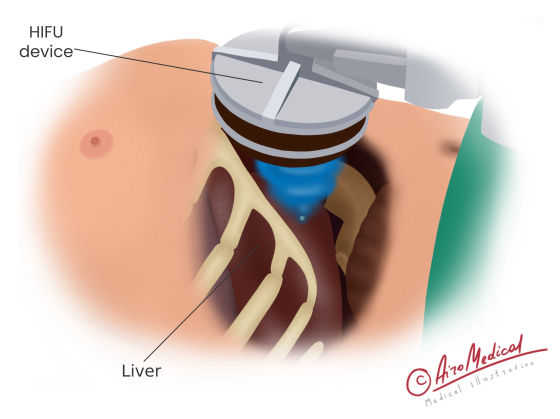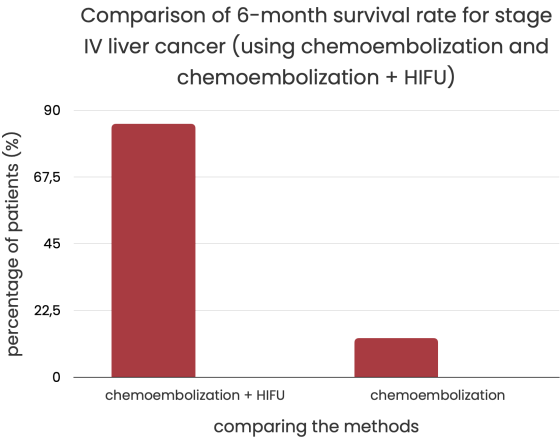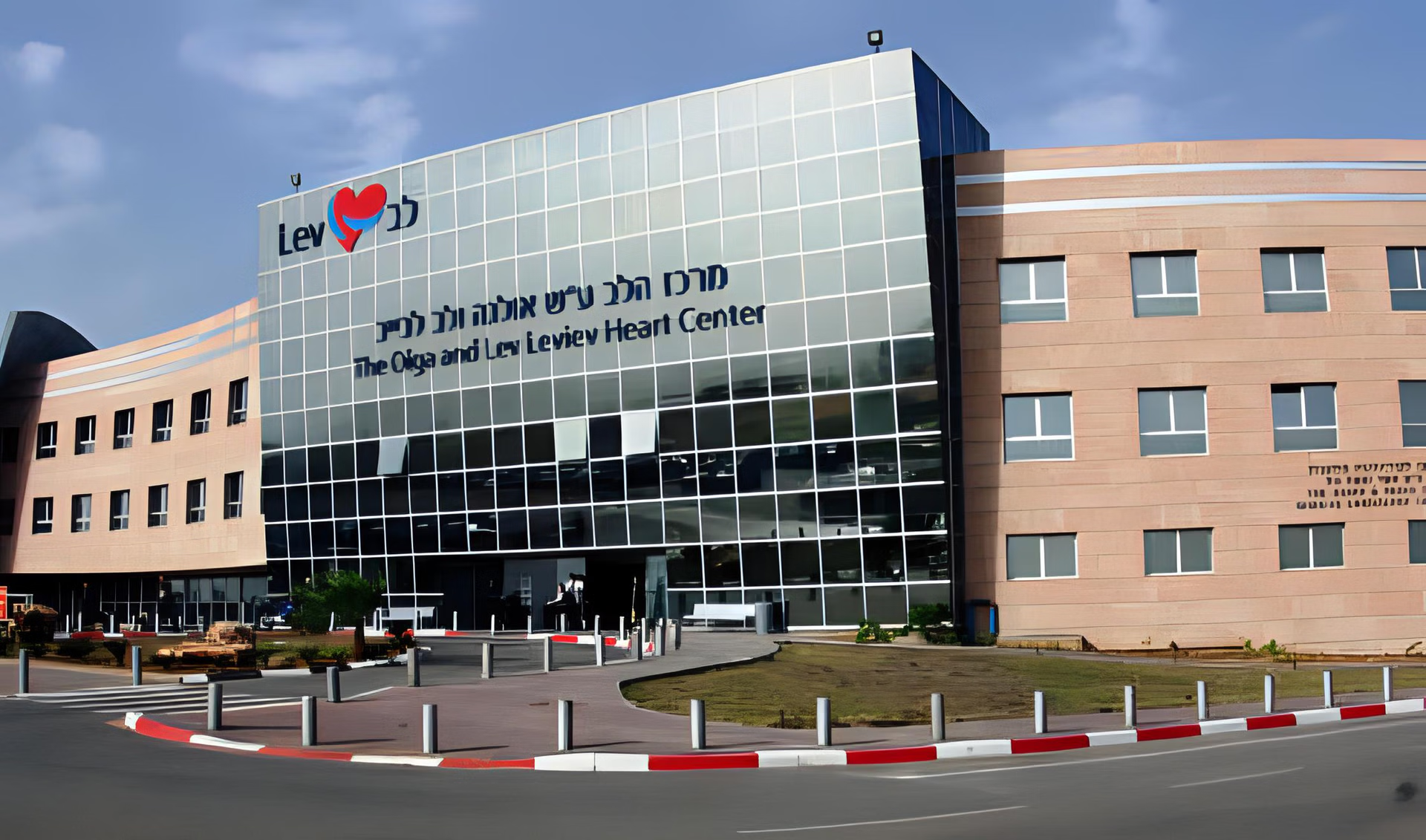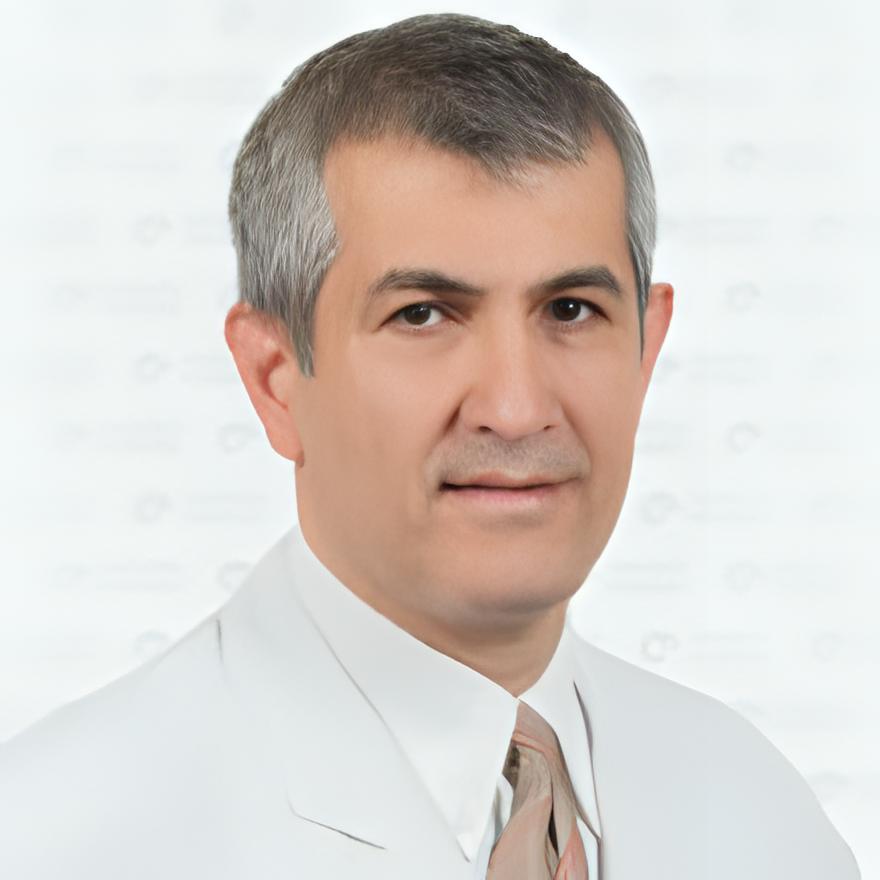High-Intensity Focused Ultrasound (HIFU) for Liver Cancer Treatment

With HIFU alone, the 1-year survival rate for liver cancer is about 80%.
More than half of the tumor cells died after just one HIFU for liver cancer.
Ultrasound heats cancer cells to more than 60°C in one second, destroying tumor proteins.
The complication rate is 8.1% for patients with hepatocellular carcinoma after HIFU treatment.
 What is High-Intensity Focused Ultrasound?
What is High-Intensity Focused Ultrasound?
HIFU is a non-invasive thermal technique for treating patients with solid tumors, both primary cancers and metastatic ones. HIFU treatment for liver cancer allows removing cancerous tissues without incisions and surgery, making cancer treatment less invasive and more comfortable for patients.
Researchers have found that subjecting cancer cells to high temperatures ranging between 65-85°C has been remarkably effective in achieving this goal. When ultrasound energy is focused on the tumor, it heats the cancerous tissue and causes it to die. It is called coagulation necrosis.
 How does it work?
How does it work?
It's fascinating to know that cancer cells can be eliminated without causing harm to the healthy tissues around them. Ultrasonic rays during HIFU liver cancer treatment can go through the layers of tissue without changing them until they target the place they are meant for, the tumor lesion.
Two biological effects take place in the body, thermal and non-thermal
- The thermal impact: Cancer cells are subjected to ultrasound at temperatures above 60°C (140°F) only for one second, causing them to heat up and be destroyed.
- The non-thermal effect: Cavitation occurs when ultrasound creates air bubbles. The shock waves or tiny jet streams these air bubbles produce a pressure of 20-30000 atm and heat. They destroy cancer cells.
This method continues to show positive results, and it could revolutionize cancer treatment and bring hope to patients.
 A detailed description of the HIFU method
A detailed description of the HIFU method
High-Intensity Focused Ultrasound provides a less invasive alternative to traditional surgical procedures, reducing the risk of complications and offering a faster recovery time.
 The HIFU procedure involves the following steps
The HIFU procedure involves the following steps
- Pre-treatment imaging: To accurately locate the tumor and plan the High-Intensity Focused Ultrasound treatment, doctors use imaging techniques such as ultrasound, magnetic resonance imaging (MRI), or computed tomography (CT) scans.
- Patient positioning and preparation: The patient is on the treatment table. A water-based gel that conducts the ultrasound waves is applied to the skin, ensuring better contact between the skin and the HIFU transducer.
- Treatment planning: Using the pre-treatment imaging, the doctor maps out the target area and determines the appropriate ultrasound energy level, focal depth, and pulse duration required for effective treatment.
- HIFU treatment: The HIFU device, equipped with a transducer, is placed on the skin above the tumor. It emits focused, high-intensity ultrasound waves that penetrate the body, targeting and destroying the cancer.
- Post-treatment monitoring: After the HIFU procedure, the patient may undergo follow-up imaging to confirm that the tumor has been successfully aimed. Patients can mainly return home the same day and resume their daily activities shortly after.
Using general or local anesthesia during the High-Intensity Focused Ultrasound for liver cancer ensures the patient feels comfortable and relaxed.
Treatment time depends on tumor size and health. It takes 1-3 hours, totaling 2-6 hours, including prep and checks.
 HIFU treatment indications for liver cancer patients
HIFU treatment indications for liver cancer patients
High-Intensity Focused Ultrasound for the treatment of liver tumors can be used in these situations:
Who might be the right candidate?
- Early-stage liver cancer: HIFU is used for patients with small tumors that haven't spread.
- Ineligibility for surgery: HIFU fits those who can't have surgery due to poor health, liver cirrhosis, or other reasons.
- Liver metastases HIFU is a promising treatment option for liver metastases, offering a non-invasive and targeted approach to manage the spread of cancer cells in the liver.
- Recurrence after surgery: High-Intensity Focused Ultrasound treats liver cancer that comes back after surgery or other treatments.
- Unresponsive to other therapies: HIFU suits patients who haven't responded well to chemotherapy, radiotherapy, or targeted therapy.
- Palliative care: High-Intensity Focused Ultrasound helps to relieve symptoms and improve the quality of life for patients with advanced or unresectable liver cancer.
A team of healthcare professionals will assess each patient's case to decide if HIFU is the right treatment option.
The best places for HIFU therapy
 Advantages and risks of HIFU treatment
Advantages and risks of HIFU treatment
High-Intensity Focused Ultrasound is an attractive option for patients. At the same time, it is essential to consider both the advantages and risks associated with HIFU before deciding if it is the proper treatment for liver cancer patients.
Benefits of HIFU
- Non-invasive treatment does not require surgery or incisions, reducing the risk of infection and shortening recovery time.
- Precise targeting helps save healthy liver tissue, minimizing damage to the liver and nearby organs.
- There are fewer side effects than traditional treatments like chemotherapy and radiation, resulting in less pain, nausea, and fatigue.
- The outpatient procedure allows patients to return home the same day and reduces disruption to their daily lives.
- Repeatable treatment can be performed multiple times without significantly increasing the risk of complications.
- Treat hard-to-reach tumors near large blood vessels, bile ducts, or vital organs that may be difficult or impossible to treat with surgery.
- Quick return to daily life or their regular activities within 24 hours, causing minimal disruption to their lives.
- Works well with other cancer treatments, creating a well-rounded approach to liver cancer care.
Risks of HIFU
- Limited effectiveness: High-Intensity Focused Ultrasound is most effective for small or early-stage liver cancer and may be less effective for larger or advanced-stage cancer tumors.
- Incomplete tumor destruction: HIFU may not destroy the entire tumor, requiring additional treatment methods to ensure complete eradication.
- Pain and discomfort: Some patients may experience mild to moderate pain or discomfort during the High-Intensity Focused Ultrasound procedure, but this can usually be managed with medication.
- Risk of injury to nearby organs: HIFU has a slight chance of damage to surrounding tissues and organs due to the heat generated by the focused ultrasound waves.
- Technical limitations: High-Intensity Focused Ultrasound is a relatively new technology, and its long-term effectiveness and safety are still being studied. Not all hospitals and cancer centers have access to HIFU technology, which may limit its availability for some patients.
HIFU offers a promising alternative for treating liver cancer, with significant advantages over traditional methods. However, it is essential to weigh these benefits against the potential risks and consult with a qualified medical professional to determine if it is the right treatment option for each patient. The AiroMedical team will help.
The HIFU doctors who will help
 Results and statistics
Results and statistics
Clinical trials using focused solid sound waves to treat liver cancer started in the 1990s in Europe, the US, and Japan. Since then, this method has proven safe and effective in destroying cancer cells. The US Food and Drug Administration has approved High-Intensity Focused Ultrasound to eliminate cancer cells.
Current research examines HIFU to treat primary and secondary liver cancer, which has spread to the liver from other body parts. Furthermore, clinical studies are being conducted to assess the potential benefits of combining High-Intensity Focused Ultrasound with other treatment options for primary liver cancer and to determine if it can help manage the symptoms of progressive disease.
Overall effectiveness
In a study published in the Journal of Cancer, researchers found that 79% of patients who underwent HIFU treatment experienced a reduction in tumor size. In 30% of these cases, the tumor was completely eradicated. This research highlights the potential of High-Intensity Focused Ultrasound therapy as an effective treatment for inoperable liver cancer. The study also found that 44% of patients diagnosed with cancer in the 1st or 2nd stage survived for over five years.
Treatment results compared to other methods

Another study led by Sheung Tat Fan and his team explored the efficacy of combining HIFU with chemoembolization, compared to chemoembolization alone, for patients with stage IV liver cancer. The results demonstrated that patients who received the combined High-Intensity Focused Ultrasound therapy and chemoembolization had a six-month survival rate of 85.4%. In contrast, those who underwent chemoembolization alone had a survival rate of just 13.2%. Based on these findings, HIFU treatment has emerged as a highly effective option for modern liver cancer treatment.
 Liver HIFU with AiroMedical: How can we help?
Liver HIFU with AiroMedical: How can we help?
AiroMedical is your go-to healthcare partner for advanced liver cancer treatments like HIFU. Our unique approach focuses on finding the best possible care for each patient. With a team of top HIFU experts, we carefully examine each case and explore all potential treatment options.
To find the most suitable solutions, we search the National Center for Biotechnology Information (NCBI) and collaborate with doctors worldwide to ensure you receive the best possible care.
At AiroMedical, we offer more than just regular medical tourism. We create personalized plans that cater to your specific needs, aiming to achieve better results and improve your well-being. In addition to organizing treatments, we also handle logistics like travel and accommodation, allowing you to focus solely on your recovery.
Choose AiroMedical for a comprehensive healthcare experience that goes above and beyond to provide you with the best care and support throughout your journey to recovery.
Countries to HIFU liver cancer treatment
References:
- Zhou YF. High-intensity focused ultrasound in clinical tumor ablation. World J Clin Oncol. 2011;2(1):8-27. doi:10.5306/wjco.v2.i1.8. PMID: 21603311; PMCID: PMC3095464.
- Wang J, Wan L, Wu Y, et al. Comparison of high-intensity focused ultrasound and microwave ablation for treating small liver metastatic tumors. J Int Med Res. Published online April 7, 2023. ORCID: 0000-0002-6405-4695.
- Ji Y, Zhu J, Zhu L, Zhu Y, Zhao H. High-Intensity Focused Ultrasound Ablation for Unresectable Primary and Metastatic Liver Cancer: Real-World Research in a Chinese Tertiary Center With 275 Cases. Front Oncol. 2020;10:519164. Published online October 29, 2020. doi:10.3389/fonc.2020.519164.
- Leslie T, Ritchie R, Illing R, Ter Haar G, Phillips R, Middleton M, Wu F, Cranston D. High-intensity focused ultrasound treatment of liver tumors: post-treatment MRI correlates well with intra-operative estimates of the treatment volume. Br J Radiol. 2012;85(1018):1363-1370. doi:10.1259/bjr/56737365. PMID: 22700259; PMCID: PMC3474034
- Mearini L. High intensity focused ultrasound, liver disease, and bridging therapy. World J Gastroenterol. 2013;19(43):7494-7499. doi:10.3748/wjg.v19.i43.7494. PMID: 24282341; PMCID: PMC3837248.











